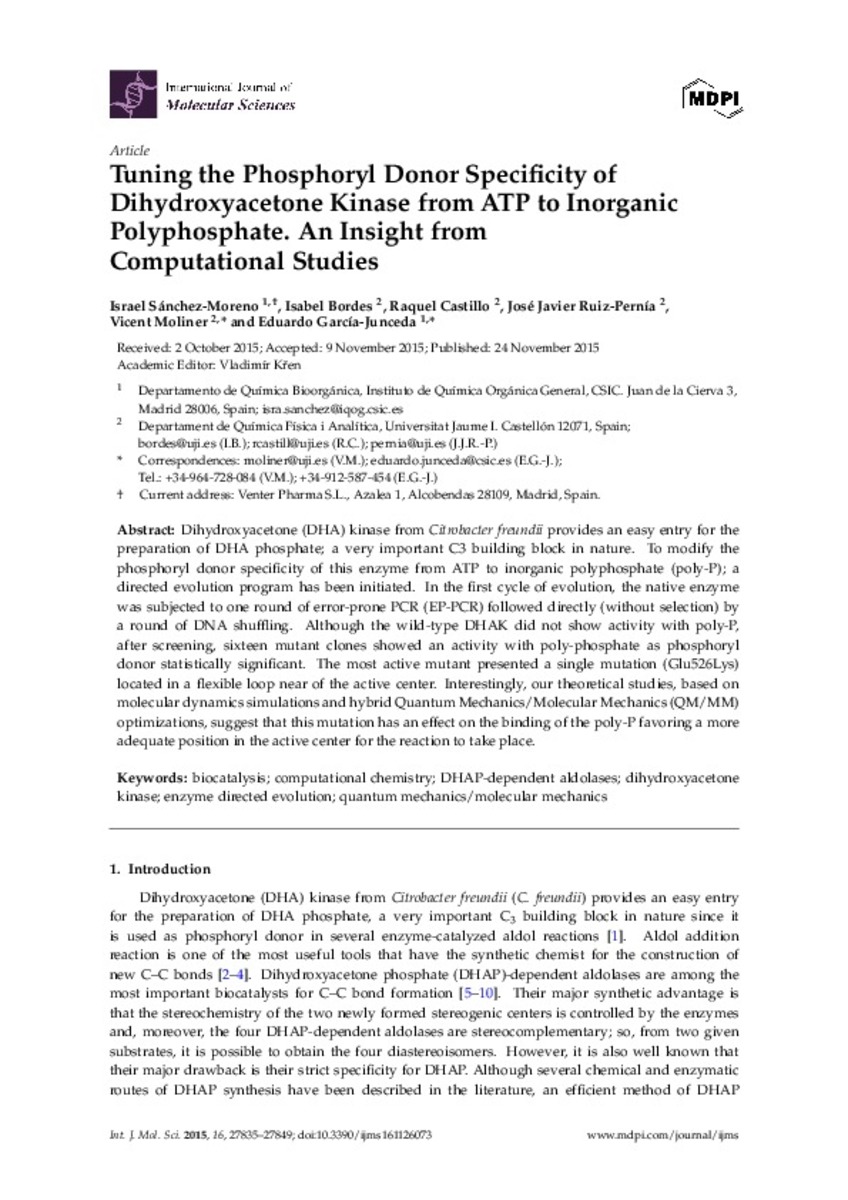Mostrar el registro sencillo del ítem
Tuning the Phosphoryl Donor Specificity of Dihydroxyacetone Kinase from ATP to Inorganic Polyphosphate. An Insight from Computational Studies
| dc.contributor.author | Sánchez Moreno, Israel | |
| dc.contributor.author | Bordes, Isabel | |
| dc.contributor.author | Castillo, Raquel | |
| dc.contributor.author | Ruiz-Pernía, José Javier | |
| dc.contributor.author | Moliner, Vicent | |
| dc.contributor.author | García Junceda, Eduardo | |
| dc.date.accessioned | 2016-03-01T10:50:24Z | |
| dc.date.available | 2016-03-01T10:50:24Z | |
| dc.date.issued | 2015-11-24 | |
| dc.identifier.citation | SÁNCHEZ-MORENO, Israel, et al. Tuning the Phosphoryl Donor Specificity of Dihydroxyacetone Kinase from ATP to Inorganic Polyphosphate. An Insight from Computational Studies. International journal of molecular sciences, 2015, vol. 16, no 11, p. 27835-27849. | ca_CA |
| dc.identifier.issn | 1661-6596 | |
| dc.identifier.issn | 1422-0067 | |
| dc.identifier.uri | http://hdl.handle.net/10234/152005 | |
| dc.description.abstract | Dihydroxyacetone (DHA) kinase from Citrobacter freundii provides an easy entry for the preparation of DHA phosphate; a very important C3 building block in nature. To modify the phosphoryl donor specificity of this enzyme from ATP to inorganic polyphosphate (poly-P); a directed evolution program has been initiated. In the first cycle of evolution, the native enzyme was subjected to one round of error-prone PCR (EP-PCR) followed directly (without selection) by a round of DNA shuffling. Although the wild-type DHAK did not show activity with poly-P, after screening, sixteen mutant clones showed an activity with poly-phosphate as phosphoryl donor statistically significant. The most active mutant presented a single mutation (Glu526Lys) located in a flexible loop near of the active center. Interestingly, our theoretical studies, based on molecular dynamics simulations and hybrid Quantum Mechanics/Molecular Mechanics (QM/MM) optimizations, suggest that this mutation has an effect on the binding of the poly-P favoring a more adequate position in the active center for the reaction to take place. | ca_CA |
| dc.description.sponsorShip | Spanish Ministerio de Ciencia e Innovación (Grants CTQ2007-67403/BQU, CTQ2010-15418 and PI11/01436), Ministerio de Economía y Competitividad (project CTQ2012-36253-C03-01), Comunidad de Madrid (Grant S2009/PPQ-1752), Generalitat Valenciana (PROMETEOII/2014/022), and Universitat Jaume I (project P1 1B2014-26) | ca_CA |
| dc.format.extent | 15 p. | ca_CA |
| dc.format.mimetype | application/pdf | ca_CA |
| dc.language.iso | eng | ca_CA |
| dc.publisher | MDPI | ca_CA |
| dc.relation.isPartOf | International journal of molecular sciences, 2015, vol. 16, no 11 | ca_CA |
| dc.rights | Attribution 4.0 Spain | * |
| dc.rights.uri | http://creativecommons.org/licenses/by-sa/4.0/ | * |
| dc.subject | Biocatalysis | ca_CA |
| dc.subject | Computational chemistry | ca_CA |
| dc.subject | DHAP-dependent aldolases | ca_CA |
| dc.subject | Dihydroxyacetone kinase | ca_CA |
| dc.subject | Enzyme directed evolution | ca_CA |
| dc.subject | Quantum mechanics/molecular mechanics | ca_CA |
| dc.title | Tuning the Phosphoryl Donor Specificity of Dihydroxyacetone Kinase from ATP to Inorganic Polyphosphate. An Insight from Computational Studies | ca_CA |
| dc.type | info:eu-repo/semantics/article | ca_CA |
| dc.identifier.doi | http://dx.doi.org/10.3390/ijms161126073 | |
| dc.rights.accessRights | info:eu-repo/semantics/openAccess | ca_CA |
| dc.relation.publisherVersion | http://www.mdpi.com/1422-0067/16/11/26073/html | ca_CA |
| dc.type.version | info:eu-repo/semantics/publishedVersion | ca_CA |
Ficheros en el ítem
Este ítem aparece en la(s) siguiente(s) colección(ones)
-
QFA_Articles [812]
Articles de publicacions periòdiques








